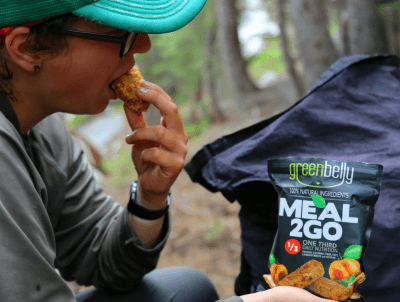
If you’re a backpacker you already know getting enough calories and nutrition on the trail can be a challenge. Those of you just getting started, you’re about to find out! Getting meals into the hands of backpackers that are both nutritious and high in calories is the holy grail.
After finding this out firsthand, one backpacker founded Greenbelly to help solve this problem. Recently I had an opportunity to test out some of the Greenbelly trail meal bars. In today’s article, I’ll give you my thoughts on the brand and its products.
What are Greenbelly Meal2Go Bars?
Meal2Go bars come 2 per pack. They weigh in at about 5.5 ounces and are meant to be loaded with nutrition. Mostly the bars are focused on natural ingredients. You’ll find things like rice, dried fruits, nuts, cocoa, honey, and peppers.Each pack of bars is meant to pack in 650 Calories or more. Additionally, they’re designed to give 25% or more of your daily value of calories, proteins, fiber, fats, sodium, and carbohydrates.
How do they stack up?
Crunching the Numbers
One of the hardest nutritional intake numbers to meet on the trail can be sheer Calories. For instance, this article, suggests calorie burn rates for a day of backpacking that ranges from 4,600 to 6,344 Calories. Why the range? Because it depends a lot on how much weight you’re carrying, how long you’re hiking, how fast, how much elevation you cover, etc.As a note, these calorie burn rates are similar to estimates I’ve come up with in the past on personal backpacking trips.Either way, it gives us some numbers to work with.My pack of Meal2Go Peanut/Apricot lists 665 Calories for the whole package. On the low end of our Calorie burn range, this package accounts for just 14% of the Calories needed on a 4,600 Calorie day. On the high end, this package accounts for just 10% of the daily caloric output if a backpacker burns 6,344 Calories.Given that the package boldly claims to “provide over 25% of your daily nutrition calories” I’d say it’s a bit misleading to the average backpacker. I mean, according to Health.gov adult females are estimated to need 1,600 – 2,400 Calories per day, while males may need as many as 3,000 Calories per day under non-hiking conditions. Put a heavy backpack on and lug it up the mountain for 8-12 hours and you’re sure to need a lot more than that.All that said, it doesn’t mean you shouldn’t eat these!Also, please note that other nutritional factors besides Calories are important. These bars do offer high quantities of many nutritious ingredients and getting a diverse intake of nutrition on the trail can sometimes be a challenge. Because dietary nutrition is an advanced, nuanced subject and I am not an expert in personal nutrition I won’t weigh in much on these factors.
Note
In fairness to the company, I suspect their advertising is based on Daily Value from the Recommended Dietary Allowance in which case their statements appear accurate. However, care should be taken to consider these numbers in the context of high-output backpacking exercise.
Caloric Density
These bars really do have something to offer in terms of belonging in your backpack. While I don’t think they quite live up to their advertising, I do think they actually rank well for caloric density.Caloric density is a measure of the number of Calories per ounce of food. This is important in backpacking because the weight of the food you can carry is limited at the top end. Therefore more calorie-dense foods are ideal.If you take the Meal2Go Peanut/Apricot bars and divide 665 Calories by the 5.47-ounce package weight you’ll find that they have a caloric density of 121.57 Calories per ounce.This makes them better than oats, many kinds of cheese, rice, Pop-Tarts, and many other common trail staples (reference). In fact, they’re actually pretty close to one of my all-time favorites, the Snickers bar which ranks at 134.4 Calories per ounce.Unfortunately, this also ranks the Meal2Go Peanut/Apricot (121.57 Cal/oz) lower than a top competitor, the ProBar Meal Superfood Slam which cranks in at 127 Calories per ounce.So, compared to many basic staples they’re pretty dense, but they’re neck-in-neck with some other competitor’s bars so it may make the final decision a tough call purely in terms of performance.
Flavors
It’s a tough market with tough competition in the high-performance meal bar world. So, when it’s hard to decide between backpacking meal bars, flavor choices will eventually have to be considered.While I don’t know what flavors readers might like, I can make a few observations.The Meal2Go bars I received have a much more savory flavor overall than most other bars I’ve tried. Most of the flavors are rich with earthy, spicy, or subdued flavors that seem to span a wide swath of cultural inspiration.While I don’t absolutely love all of the flavors, I did notice something really important.These bars are way less gag-me-sweet than many other hiking meal bars I’ve eaten. Even though Tapioca Syrup is near the top of the list of ingredients on most, or all, of the bars, they’ve done a good job balancing flavors.Here’s a list of the flavors you can find:
- Dark Chocolate/Banana
- Peanut/Apricot
- Cranberry/Almond
- Mango/Cashew/Coconut
- Spiced/Caramel/Apple
As a heavy proponent of Snickers Bars, olive oil, and other high-calorie backpacking foods, I can say variety is sometimes scarce. It’s actually really nice to see these bars bring in a broader and more diverse flavor profile.I had the spiced caramel apple bar the other day and there’s no doubt it’s a huge departure from your average meal bar.For backpackers, each next meal or snack can define the mood of the day. Don’t underestimate the power of looking forward to something that brings a burst of energy wrapped in flavors and textures that aren’t bland trail food mush.
Cost
While some of you may not care how much you spend on trail food, I know many of you do (me included). Value is always a factor when I choose anything that goes on the trail with me.According to the Greenbelly website at the time of writing, a single meal bar pack ranges from $7.40 per package to $6.17 per package.If we compare that, purely in terms of Caloric value, to the ProBar Superfood Slam this is what we get:
- ProBar: 116.9 Calories per dollar spent (380 Calories/$3.25 per bar)
- Greenbelly Meal2Go Bar: 100.5 Calories per dollar spent (650 Calories/$6.47 per bar)
Note
These comparisons use the Pro Bar price for a 12-pack and the Meal2Go Bar price for a 15-pack. The final value will change based on deals, sales, price changes, and bulk discounts.Of course, Calories per dollar is a very crude metric and fails to take into consideration many subjective factors such as personal preference or nuanced meal nutritional values. However, it is a useful metric if you’re budgeting for food over the course of a multi-month thru-hike.
Conclusion
To wrap up this review and put a bow on it, let me say that I think the Greenbelly Meal2Go bars definitely offer a good choice for backpackers.Which meal bars you want to take into the field may depend on many factors. Price, value, and caloric density are objective factors we can consider. However, these factors completely fail to appreciate things like texture, flavor profiles, certified organic ingredients, or corporate morals.If you’re sick of over-sweetened meal bars or bland syrup-induced goo flavors in your meal bars then I certainly think the refreshingly crisp, varied, and rich tones of flavors in the Meal2Go Bar family will be a breath of fresh air in your backpacking meals.



